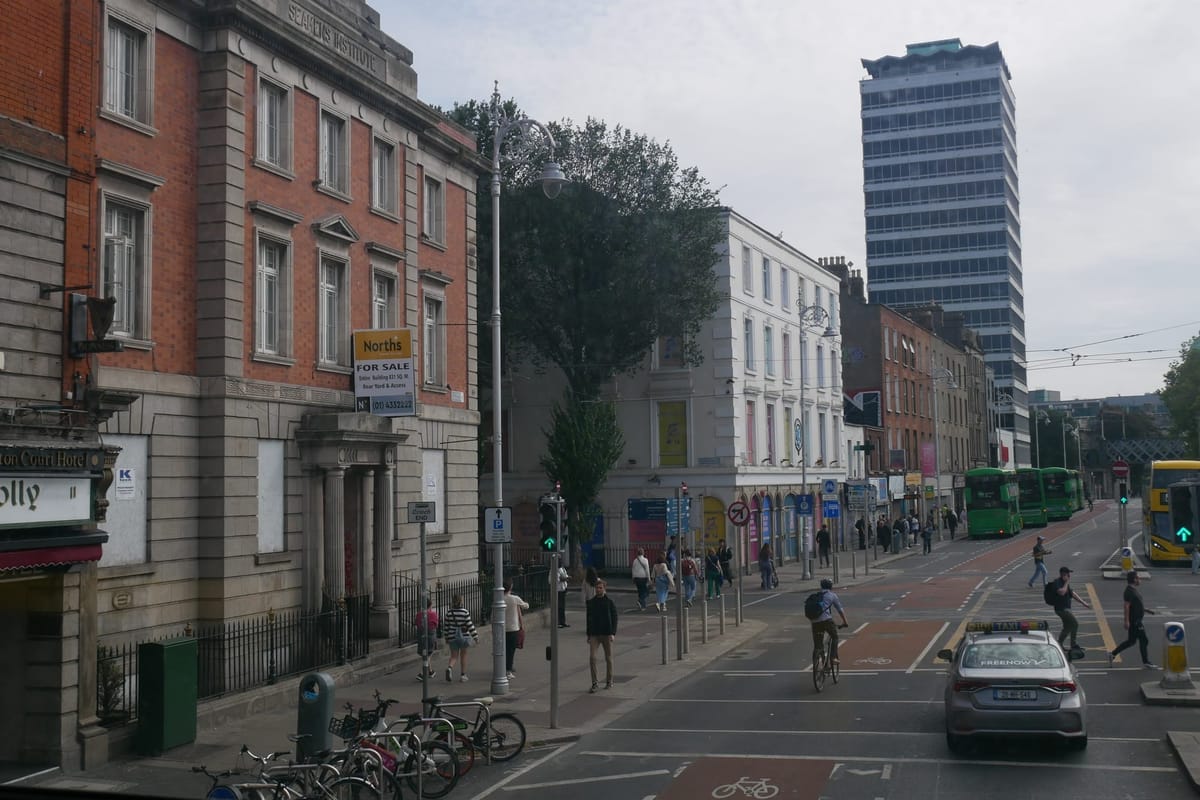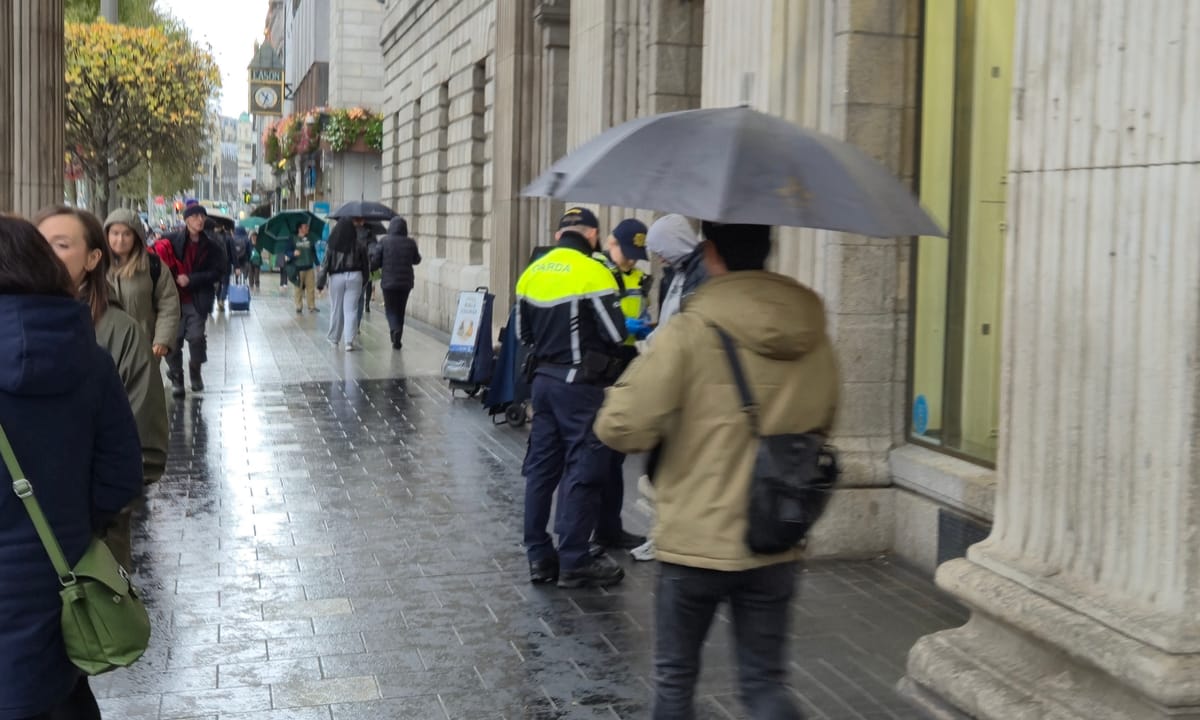New survey offers insights into levels of crime in Dublin city centre
The City Centre Crime Victim Survey was commissioned by Dublin Inquirer and carried out by Amarách Research.
This has serious impacts on businesses and social life in town.

Emmy Shigeta doesn’t really have an ideal route back to her apartment after work.
She has a weekly DJ slot on Sunday evenings from 6pm to 11.30pm in Fidelity, a bar near Smithfield, she says. “And always, always, I’m not happy going back home.”
Her place is just off Lower Dorset Street, and heading down towards Smithfield is generally fine during daylight hours, she says. “Not safe. But okay.”
Night-time though, is a different story, she says. “It’s very dodgy. I’m very nervous.”
There were a couple of times when she felt like someone was following her, she says. “Once, I saw, when I was walking on the road, there was a car on fire.”
The bus services can’t bring her to her front door, nor does the Luas’ Red Line, she says. “My house is not too far away from the city centre. But I always have to get a taxi.”
Once the sun goes down, unless it’s for a gig, she tends to avoid going out, she says. “If I have a friend's birthday or some celebration like that, of course, I have to go.”
But otherwise, she’s hesitant to do something like grab a casual pint with a friend, she says. “Sometimes, I feel like I’m not comfortable, because of how I get back home.”
Shigeta resides just within the city centre, an area that was roughly defined – for the purposes of our new City Centre Crime Victim Survey – as the parts of the city within the North and South Circular Roads, as well as East Wall and the Grand Canal Basin.
And it is an area that about two-thirds of respondents who did not live there said they avoid because they feel it is too unsafe, according to the survey, commissioned by Dublin Inquirer and carried out by Amárach Research.
The survey, which drew on a sample of 600 people over the age of 18 living in Dublin and Leinster, found that, of the 505 participants residing outside the city centre, 63 percent said they sometimes or often avoid going there.
There was a substantial gender split, with 53 percent of men saying they avoid visiting the city centre, and 72 percent of women.
The feeling that there is a lack of safety in the city is a huge, highly complex issue right now, says Labour TD Marie Sherlock. “It is really stark, the number of people living in the city who are terrified of walking down certain streets in the inner-city. It’s a very sad thing.”
The perception that the city centre is too unsafe to visit has serious impacts on businesses, and on social life in town. Although, the survey shows that the actual levels of crime that respondents experienced are vastly lower than the levels of fear.


Shigeta, who is originally from Tokyo, moved to Dublin city in 2018, and in those seven years, the capital hasn’t felt like too unsafe a place to be, generally, she says. “But, I feel like there is no safety at night time.”
Things that survey respondents who live outside the city centre said were big issues there included rubbish on the streets, drug taking, drug dealing, and physical violence/assault.
In mid-September, Social Democrats Councillor Cat O’Driscoll reported that she was physically assaulted on Dorset Street around 6pm, O’Driscoll says.
She was approached by a man while she was wearing headphones, she says. “He said something to me, and while he said it, he hit me across the side of the head quite forcefully.”
The only person who stopped to check on her wellbeing was a woman driving by in a car, she says. “She rolled down her window, and said I should call the Garda.”
That is something that the city is missing, she says. “We’ve lost that kind of kindness, maybe. People checking in with people. I’m not asking anyone to get involved in a violent situation where they can be hurt.”
O’Driscoll, who is currently the chair of Dublin City Council’s women’s committee, says she wants the committee to organise more training for councillors in handling cases of gendered violence, she says. “And we want to build into that bystander training.”
People maybe aren’t confident enough to feel they can check on the wellbeing of someone who has been assaulted, O’Driscoll says. “You don’t have to be a medic to ask ‘Are you okay?’ or ‘Do you need anything?’”
Says O’Driscoll: “It’s a bit like the mental health campaign, saying ‘It’s okay not to be okay’. It should be okay to ask someone if they are okay. And we’re looking for training from an expert. We just need to get funding for, because it’s an area I’m keen to do more work on.”
In September, the council announced it was rolling out a new “safe and sound” training initiative – but that’s targeted at businesses and workers in the night-time economy.
Drug use and drug dealing in the city centre have been highlighted by businesses and residents living around the Temple Bar area, says Stephen Kennedy, the founder of Copper + Straw Speciality Coffee Shop.
Originally opened in Bray, Copper + Straw expanded to add two additional shops in Dublin city, one on Arran Quay next to Smithfield, and another on Aston Quay on the edge of Temple Bar.
The latter, Kennedy opened in October 2022, he says. “And that was a very challenging time. My observations and our experiences at the time was that there was a very high level of drug dealing, and drug use, probably on an industrial scale at that stage.”
The Aston Quay shop was robbed at knifepoint that November, he said. “That was during the day, with staff locked in the toilets.”
Aston Quay is an area with a high footfall, he says. “A lot of tourists have their first experience of Dublin on that street, so it’s really important that we are doing everything to improve the area.”
But it was a real challenge, trying to get started on the quay, he said. “It motivated me to look around, talk to other businesses, and get a sense of what their experience was.”
Kennedy and other local businesses on the quay decided join up with the local residents association to establish the Aston Quay and Temple Bar Business and Residents’ Alliance in August 2023, he says.
It is a single-issue group, consisting of Temple Bar residents and 47 local businesses, he says. “We just work on the issue of open drug dealing.”
In March, the Alliance produced its own survey, consisting of 458 people’s experiences, and developed with the intention of laying out key proposals for improving the area, according to the Copper + Straw website.
These, the website says, include a dedicated high-visibility Garda unit to tackle street-level drug dealing, enforcement of drug laws, more CCTV, better lighting, and the regeneration of the laneways.
Ian Marder, an associate professor of criminology at Maynooth University, says that it is problematic to expect gardaí to continue to handle social issues and to funnel more money towards that approach.
Gardaí are asked to do things that could be better looked after by alternative services – such as responding to mental health crises or drug consumption, he said.
“They have to balance that their resources will consistently be pulled in that direction against the fact that certain things that are commonly said to be very serious, like protecting people who are at risk of domestic violence, investigating serious sexual violence which take a lot of time to investigate,” he said.
On Tuesday evening, as the staff in Copper + Straw’s Aston Quay branch were closing up at 4pm, a pair of Garda were driving down the laneway that runs alongside the cafe.
Kennedy says he has noticed some improvements around the Temple Bar area in the past 12 months. “In terms of the reduction of open dealing and drug use, I wouldn’t say it’s gone away, but it’s certainly got a lot better.”
He didn’t mention the Merchants Quay supervised injection centre which opened last December in the city centre.
But, among the Aston Quay and Temple Bar Business and Residents’ Alliance recommendations, it proposed reducing the concentration of drug-related services in central Dublin, “while ensuring support is available across the greater Dublin area.”
They would prefer a more equitable distribution of these services across the greater Dublin area, Kennedy says. “It’s not that support should be reduced, but provided in a more balanced way.”
In October 2024, the Dublin City Taskforce recommended spreading hostels more around the region. The Programme for Government says it will consider the appropriate distribution of drugs and homeless services.
The Department of the Taoiseach was currently engaging with government agencies to map all existing services “to inform next steps”, council chief executive Richard Shakespeare wrote last month.
Since the start of 2025, he has seen a lot of changes to public-order policing in the city centre, said Kennedy. “It’s been an absolute game-changer.”
High-visibility foot patrols have had an enormous impact, he says.
According to a Garda press release, published on 9 October, the High Visibility Policing Plan –which has been in place since March – has led to an increase in the detection of public order offences.
The detection of drunkenness offences has risen by 67 percent in that period, while drug possession has gone up 30 percent, and sale or supply has risen by 3 percent, the release says.
Also, as part of this plan, An Garda Síochána has been operating a pop-up clinic in and around the Docklands area since July, with its location rotating between the north side and south side.
A Garda spokesperson declined to provide any information on whether it intends to expand beyond these locations, saying Gardaí do not comment on policing operations in the future.
Good policing is a starting point for reassuring people about coming to the city centre, says Sherlock, the Labour TD. “But Gardaí are hugely stretched. We’ve a force of about 14,000 that needs about 18,000.”
There have been increases in areas like O’Connell Street, she says. “But we need smart policing, finding where the spots are that dealing is taking place on a certain morning.”
The Department of the Taoiseach’s Dublin City Taskforce recommended in its October 2024 report that the Department of Justice approves funding to help train “a minimum of 1000 additional gardaí in Dublin on a phased basis over the next three years”.
A Garda spokesperson said on Friday that it is working with its partners to ensure the Programme for Government’s commitment to hire 5,000 Gardaí over five years is met.
The taskforce has also recommended that Dublin City Council establish a city warden programme to carry out actions like enforcing bye-laws and operate mobile safety vehicles, as well as liaising with local businesses and promoting social activities, its report says.
That scheme is included in the taskforce’s roadmap, published in June, and a council spokesperson said on Monday that currently, it is currently supporting the pilot Community Safety Warden programme in Capel Street, O’Connell Street and the surrounding environs.
A city warden programme will be looked at following a review of the current community safety warden concept, they said.
Note: If you’d like to explore the City Centre Crime Victim Survey data, you can find an array of tables in this spreadsheet. We also have an SPSS file, get in touch if you’d like that: sam@dublininquirer.com.
Funded by the Local Democracy Reporting Scheme.